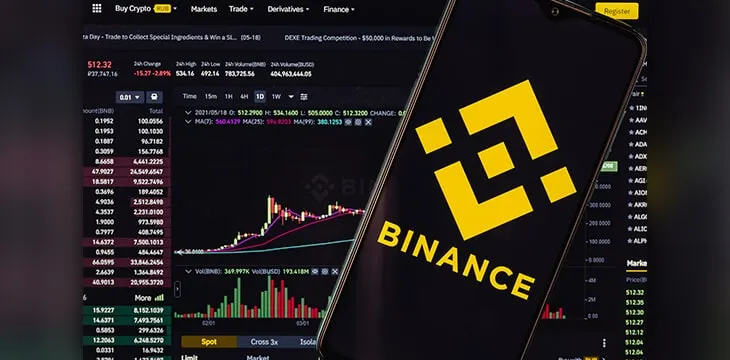|
Getting your Trinity Audio player ready...
|
Binance customers who lost big betting on the cryptocurrency exchange’s leveraged tokens will likely never be made whole, but their tales of woe should serve as a warning to others to get out while there’s still time.
In a YouTube video released this week, TechLead (aka Patrick Shyu) addressed the great digital currency crash of May 19, focusing on the major losses experienced by individuals who’d gotten into bed with Binance Leveraged Tokens (BLVT), which in Binance’s own words are “essentially a tokenized version of leveraged futures positions.”
https://www.youtube.com/watch?v=IG8LfZoMd_E
The 20 BLVT listed on Binance aim to generate leveraged gains in a variable range of 1.25x to 4x, depending on how their corresponding token performs. So BTCUP is supposed to rise in tandem with the price of BTC, while BTCDOWN rises when BTC falls. Crucially, the BLVT only exist on Binance, meaning users cannot withdraw the tokens to their own wallets, nor are BLVT issued on-chain.
That became a major problem on May 19, when the DOWN tokens all tanked in tandem with their corresponding tokens. Like, seriously tanked, with some BLVT suffering drops as great as 96%.
Binance’s futures platform went offline during the market meltdown, leaving BLVT holders no means of closing their positions. By the time the systems were back online, many traders had no position left to close.
Binance later claimed that the losses were due to an ‘algorithmically-driven rebalancing mechanism’ that apparently functioned as intended. Binance also claimed that customers were made aware of this possibility before they bought into these positions.
It’s worth remembering that Binance delisted a competitor’s leveraged tokens last spring due to what Binance CEO Changpeng ‘CZ’ Zhao claimed were customers’ unwillingness to read the fine print. But Zhao apparently had a rather abrupt change of heart, as Binance began issuing its bespoke BLVT just a few months later.
Wipe out
Shyu’s take on the BLVT debacle was that Binance “essentially sold people worthless tokens that did not do what they said they would do.” Worse, Shyu said Binance’s technology failing at times of crisis “seems quite common” and “during these crashes, Binance will take the opportunity to wipe you out.”
Shyu backed up this last point by noting the extreme spreads on some BLVT trades on May 19, with the exchange willing to sell you at the top and then buy back at rock bottom. Shyu said the charts detailing these spreads “just don’t look normal.”
Shyu said Binance was leveraging the SUSHIUP token at 50x during the crash, a far cry from the 1.8x-2x leverage on a normal trading day. SUSHIUP was trading around $3 before the crash, but was worth just 30¢ when the system finally came back online. The price has never really recovered after Binance “wiped everyone out with 50x leverage.”
In other words, Shyu said a customer theoretically stands to gain 2x but faces a potential loss of 50x, meaning the risk v. reward ratio in these BLVT is “just totally messed up” and the net result is “massive, massive losses” for Binance customers. Shyu said it “must be loads of fun getting fleeced by your exchange; next up, you’ll be paying child support to your exchange.”
Binance also issued millions of additional tokens during the tumult, in some cases more than triple the pre-crash total. Binance claimed that it was simply responding to market demand, but Shyu’s theory is that Binance “was probably just naked-shorting these tokens and when it came time for them to cover, they couldn’t, so they pushed all of the losses onto their customers and tried to wipe out the value of these coins.”
Remedies are few
Shyu noted that some Binance customers who’d lost significant sums reported receiving offers from the exchange that would have made good on roughly 30% of their losses. But acceptance of these offers required customers to sign gag orders prohibiting them from discussing the matter publicly, while releasing Binance from any further liability.
Customers who received such offers may actually be the lucky ones, as Shyu noted that the compensation form Binance set up “doesn’t even work anymore. Some website glitch. I don’t know… Guess it’s a bug. Call it a feature.”
Shyu said Binance’s compensation efforts to date appear to be focused on crypto whales, leaving the minnows to fend for themselves. Many of these minnows are attempting to bring legal action against Binance, but the company’s Byzantine corporate structure—Binance has a presence in 55 countries but no formal headquarters—appears designed “very strategically to evade Bitcoin regulators.”
Some aggrieved Binance users have started a Change.org petition to convince the U.S. Securities and Exchange Commission (SEC) to commence litigation against Binance for consumer fraud and false advertising. The U.S. Department of Justice (DoJ) and Internal Revenue Service (IRS) are reportedly already probing alleged money laundering and tax offenses.
Regardless of where his sympathies might lie, Shyu doesn’t let Binance customers off the hook, reminding them that “I thought you didn’t want regulation, thought you could just be your own bank.” Shyu rather dryly notes that banks hire security guards and wonders how many Binance users hired their own security to guard their holdings.
With the BLVT experiment now a cautionary tale, Shyu said the best remedy users have at their disposal is “just getting your money out of Binance so you don’t end up like one of these sheep out to slaughter.” Shyu said he personally wants nothing to do with Binance because he doesn’t want to lie awake every night worrying if his money is safe in the hands of this “really shady company.”
Follow CoinGeek’s Crypto Crime Cartel series, which delves into the stream of groups
—from BitMEX to Binance, Bitcoin.com, Blockstream, ShapeShift, Coinbase, Ripple and
Ethereum—who have co-opted the digital asset revolution and turned the industry into a minefield for naïve (and even experienced) players in the market.

 04-25-2025
04-25-2025 





